Artist Project: Christy Gast
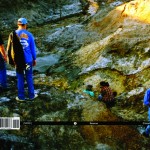
This is the cover of my forthcoming book from [NAME] Publications. It’s called “Source,” and consists of 67 images of objects that work almost like
sculptures but aren’t for various reasons. This particular image consists of several people, including myself, looking into the unfathomable—a sinkhole
that swallowed a nearly 4000 acre lake in North Florida. These men want to go inside.
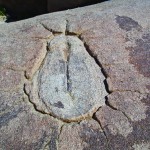
In her book “Vibrant Matter: A Political Ecology of Things,” the philosopher Jane Bennett writes about the ability of inanimate matter, not to mention
sentient beings, to move us and change who we are as people. This is a rock in California. This rock, and several nearby contain natural crevices that were
enhanced in prehistoric times to resemble disembodied female anatomy.
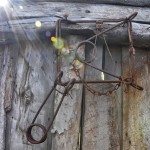
This is a beaver trap. My book is a book of images, as I said previously, of objects that are like sculpture but not. Perhaps it’s better to say they are images
that are like sculptures I would like to make. These objects, like Jane Bennet’s “Vibrant Matter,” point to systems—ecologies and systems of commerce
from which we cannot consider ourselves separate.
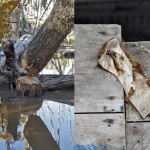
The assemblage on the left was not created by man, at least not in a direct or intentional way. It is a tree in the process of being felled by a beaver, in
the process of creating a dam, in the process of changing the ecosystem of the subantarctic forest in Chilean Tierra del Fuego that frames this scene.
Canadian Beavers were here in 1948 with hopes of spurring a fur trade. On the right is a utilitarian object, a hinge made of sheepskin. Sheep were also
imported in the early 20th century.
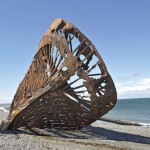
Here is a shipwreck. It’s a steel ship that found its final resting place on a deserted beach on the Strait of Magellan. This giant hulk once moved goods
from Asia to Eastern North and South America and back. The Strait of Magellan, like the Argentinean beaver trade, didn’t fit into the big picture of global
commerce after the construction of the Panama Canal, the same canal that our civic leaders hope will soon reinvigorate the Port of Miami.
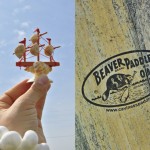
As an artist I have a particular interest in these systems, because they are what imbue objects with meaning. By objects I mean refuse, raw materials, assemblages, sculptures, even landscapes. This flea market trinket from the Upper Midwest and the graphic on this rented rowboat paddle, assembled as
such, make a brief connection between trade aspirations and ecosystem devastation.
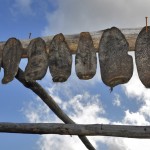
This is a trophy. The Guardas-Parques at Karukinka Natural Park in the extreme South of Tierra del Fuego, which itself is in the Extreme South of South
America, are charged with eradicating hundreds of thousands of beavers from the region. In the 18th century, French trappers in North America had no
problem bringing the beaver to near extinction. They were so successful that by the time these guys’ ancestors were imported into Tierra del Fuego there
was no market for their fur, and thus no fur trade to entice young men to become trappers.
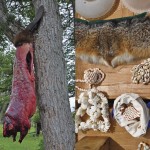
They reproduced unchecked for decades, much like the pythons in our own Everglades. This is meat. At Karukinka the Guardas Parques cannot afford
to take protein, or any fresh food for that matter, for granted. Imagine the cost of shipping a chicken breast or a head of lettuce practically to Antarctica,
across the Strait of Magellan on a ferry and then through 100’s of miles of pampas to the forest rangers. In the Upper Midwest, by contrast, these animal
parts at a roadside sale read as “vintage accessories.” This taxidermiy display, from the same flea market’s gun shop, was carefully constructed by a craftsman practicing a trade that is meaningful to very few constituencies. It is also a trophy, but one that stakes a very different claim than the beaver tails hanging from the rafter of a worn-out tool shed. This beaver promises luck, virility and success to the potential purchaser of a muzzleloader, crossbow or hunter-orange accessories.
This taxidermiy display, from the same flea market’s gun shop, was carefully constructed by a craftsman practicing a trade that is meaningful to very few constituencies. It is also a trophy, but one that stakes a very different claim than the beaver tails hanging from the rafter of a worn-out tool shed. This beaver promises luck, virility and success to the potential purchaser of a muzzleloader, crossbow or hunter-orange accessories. Jane Bennet says, “Assemblages are ad hoc groupings of diverse elements, of vibrant materials of all sorts. Assemblages are living, throbbing confederations that are able to function despite the persistent presence of energies that confound them from within.” This assemblage was made by no one.
Jane Bennet says, “Assemblages are ad hoc groupings of diverse elements, of vibrant materials of all sorts. Assemblages are living, throbbing confederations that are able to function despite the persistent presence of energies that confound them from within.” This assemblage was made by no one.